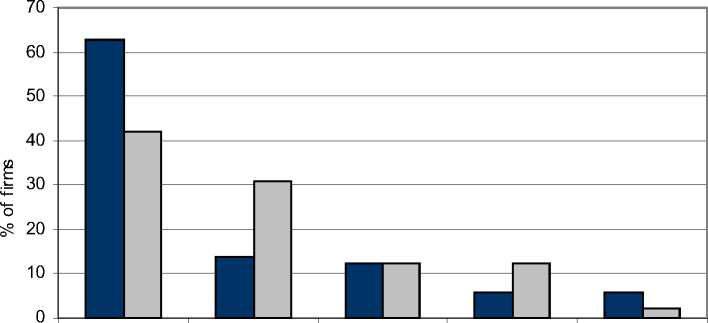13
to the traditional industries that locate in the peripheral region, while the high-tech sector
concentrate in the metropolitan area. The traditional industries rely mainly on the local
market, therefore enjoy from high accessibility to information on this market opportunities.
The hi-tech firms are more outsourcing oriented that naturally limits the accesses to sources of
information on market opportunities. Looking on the distribution of firms according to the
percent of export from turnover, confirm this hypothesis where the average percent of export
within the hi-tech firms are 51.4%, while in the more traditional firms it does not exceed 25%.
As mentioned above, the result indicated the high existence of R&D services presented in the
low rank given by the firms to the lack of R&D services effect on innovation. Yet it was
found to be higher in the peripheral region than in the metropolitan area and statistically
significant. The result depicts in Figure 3.
Figure 3: Distribution of firms (0%) according to the importance they ascribed to the
lack of R&D services as a barrier to innovation, by regions

no significant slightly moderately very significant crucial
significant significant
□ metropolitan □ periphery
The gap rely mainly in the percent of firms that ascribed no significant at all to the lack of
R&D services as stimulate the success of innovation. More than 60% of the firms in the
metropolitan area indicated so, but only 40% of the firms in the periphery. This result pointed
to one of the main disadvantages of the peripheral regions jointly to the principal one -- the
lack of highly skilled labors, but rather with much less effect. However, while public policy
probably could successfully deal with the lack of R&D services, given financial incentives to
the firms, it is much harder to handle with the lack of skilled labor in lagging regions.
4.2 The inter- sectoral analysis
More intriguing information
1. Initial Public Offerings and Venture Capital in Germany2. Global Excess Liquidity and House Prices - A VAR Analysis for OECD Countries
3. Palvelujen vienti ja kansainvälistyminen
4. The name is absent
5. The WTO and the Cartagena Protocol: International Policy Coordination or Conflict?
6. THE EFFECT OF MARKETING COOPERATIVES ON COST-REDUCING PROCESS INNOVATION ACTIVITY
7. Moi individuel et moi cosmique Dans la pensee de Romain Rolland
8. The name is absent
9. Meat Slaughter and Processing Plants’ Traceability Levels Evidence From Iowa
10. The name is absent